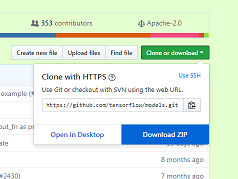实现条件:
1.win7
2.python
3.运行所需要的库:matplotlib、lxml、pillow、Cython
具体参考:https://github.com/tensorflow/models/blob/master/research/object_detection/g3doc/installation.md
4.object_detection包,下载地址:https://github.com/tensorflow/models

下载后解压 object_detection的位置在research文件夹中
5.编译好的protos文件,object_detection中的文件没有编译,编译好的文件下载地址:https://github.com/1529591487/Object-Detection
直接替换object_detection中的protos文件夹即可。
代码:
1.
import numpy as np import os import six.moves.urllib as urllib import sys import tarfile import tensorflow as tf import zipfile from collections import defaultdict from io import StringIO from matplotlib import pyplot as plt from PIL import Image # 这里改成你下载的object_detection包的位置 sys.path.append(r"E:\学习资料\人工智能\models-master\research") from object_detection.utils import ops as utils_ops if tf.__version__ < '1.4.0': raise ImportError('Please upgrade your tensorflow installation to v1.4.* or later!')
2.
%matplotlib inline
3.
from object_detection.utils import label_map_util from object_detection.utils import visualization_utils as vis_util
这里会有警告,但是不影响,如果要去掉警告的话,将models-master\research\object_detection\utils\visualization_utils.py 文件中的第26行改成
matplotlib.use('Agg',warn=False, force=True)
4.
# What model to download. MODEL_NAME = 'ssd_mobilenet_v1_coco_2017_11_17' MODEL_FILE = MODEL_NAME + '.tar.gz' DOWNLOAD_BASE = 'http://download.tensorflow.org/models/object_detection/' # Path to frozen detection graph. This is the actual model that is used for the object detection. PATH_TO_CKPT = MODEL_NAME + '/frozen_inference_graph.pb' # 这里的路径也需要修改 PATH_TO_LABELS = os.path.join(r'E:\学习资料\人工智能\models-master\research\object_detection\data', 'mscoco_label_map.pbtxt') NUM_CLASSES = 90
5.
opener = urllib.request.URLopener() opener.retrieve(DOWNLOAD_BASE + MODEL_FILE, MODEL_FILE) tar_file = tarfile.open(MODEL_FILE) for file in tar_file.getmembers(): file_name = os.path.basename(file.name) if 'frozen_inference_graph.pb' in file_name: tar_file.extract(file, os.getcwd())
6.
detection_graph = tf.Graph() with detection_graph.as_default(): od_graph_def = tf.GraphDef() with tf.gfile.GFile(PATH_TO_CKPT, 'rb') as fid: serialized_graph = fid.read() od_graph_def.ParseFromString(serialized_graph) tf.import_graph_def(od_graph_def, name='')
7.
label_map = label_map_util.load_labelmap(PATH_TO_LABELS) categories = label_map_util.convert_label_map_to_categories(label_map, max_num_classes=NUM_CLASSES, use_display_name=True) category_index = label_map_util.create_category_index(categories)
8.
def load_image_into_numpy_array(image): (im_width, im_height) = image.size return np.array(image.getdata()).reshape( (im_height, im_width, 3)).astype(np.uint8)
9.
def run_inference_for_single_image(image, graph): with graph.as_default(): with tf.Session() as sess: # Get handles to input and output tensors ops = tf.get_default_graph().get_operations() all_tensor_names = {output.name for op in ops for output in op.outputs} tensor_dict = {} for key in [ 'num_detections', 'detection_boxes', 'detection_scores', 'detection_classes', 'detection_masks' ]: tensor_name = key + ':0' if tensor_name in all_tensor_names: tensor_dict[key] = tf.get_default_graph().get_tensor_by_name( tensor_name) if 'detection_masks' in tensor_dict: # The following processing is only for single image detection_boxes = tf.squeeze(tensor_dict['detection_boxes'], [0]) detection_masks = tf.squeeze(tensor_dict['detection_masks'], [0]) # Reframe is required to translate mask from box coordinates to image coordinates and fit the image size. real_num_detection = tf.cast(tensor_dict['num_detections'][0], tf.int32) detection_boxes = tf.slice(detection_boxes, [0, 0], [real_num_detection, -1]) detection_masks = tf.slice(detection_masks, [0, 0, 0], [real_num_detection, -1, -1]) detection_masks_reframed = utils_ops.reframe_box_masks_to_image_masks( detection_masks, detection_boxes, image.shape[0], image.shape[1]) detection_masks_reframed = tf.cast( tf.greater(detection_masks_reframed, 0.5), tf.uint8) # Follow the convention by adding back the batch dimension tensor_dict['detection_masks'] = tf.expand_dims( detection_masks_reframed, 0) image_tensor = tf.get_default_graph().get_tensor_by_name('image_tensor:0') # Run inference output_dict = sess.run(tensor_dict, feed_dict={image_tensor: np.expand_dims(image, 0)}) # all outputs are float32 numpy arrays, so convert types as appropriate output_dict['num_detections'] = int(output_dict['num_detections'][0]) output_dict['detection_classes'] = output_dict[ 'detection_classes'][0].astype(np.uint8) output_dict['detection_boxes'] = output_dict['detection_boxes'][0] output_dict['detection_scores'] = output_dict['detection_scores'][0] if 'detection_masks' in output_dict: output_dict['detection_masks'] = output_dict['detection_masks'][0] return output_dict
10.
IMAGE_SIZE = (36, 24) #这里设置图片路径 mydir=r'E:\学习资料\人工智能\models-master\research\object_detection\test_images' # mydir = 'G:\壁纸' for filename in os.listdir(mydir): if os.path.splitext(filename)[1] == '.jpg': filepath=os.path.join(mydir, filename) print(filepath) image = Image.open(filepath) # the array based representation of the image will be used later in order to prepare the # result image with boxes and labels on it. image_np = load_image_into_numpy_array(image) # Expand dimensions since the model expects images to have shape: [1, None, None, 3] image_np_expanded = np.expand_dims(image_np, axis=0) # Actual detection. output_dict = run_inference_for_single_image(image_np, detection_graph) # Visualization of the results of a detection. vis_util.visualize_boxes_and_labels_on_image_array( image_np, output_dict['detection_boxes'], output_dict['detection_classes'], output_dict['detection_scores'], category_index, instance_masks=output_dict.get('detection_masks'), use_normalized_coordinates=True, line_thickness=8) fig1 = plt.gcf() plt.figure(figsize=IMAGE_SIZE) plt.imshow(image_np)
运行结果:

代码参考:https://github.com/tensorflow/models/blob/master/research/object_detection/object_detection_tutorial.ipynb
有些图片识别会失败,目前还没搞清楚,欢迎大家交流




 本文介绍如何在Windows 7系统上安装并配置基于TensorFlow的物体检测环境,包括所需库的安装、protos文件的编译及替换、模型下载等步骤,并提供了完整的Python代码示例。
本文介绍如何在Windows 7系统上安装并配置基于TensorFlow的物体检测环境,包括所需库的安装、protos文件的编译及替换、模型下载等步骤,并提供了完整的Python代码示例。
















 678
678

 被折叠的 条评论
为什么被折叠?
被折叠的 条评论
为什么被折叠?








